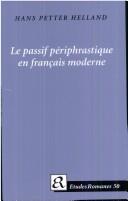| Listing 1 - 8 of 8 |
Sort by
|

ISBN: 8772896930 Year: 2002 Publisher: Copenhagen Museum Tusculanum press
Abstract | Keywords | Export | Availability | Bookmark
 Loading...
Loading...Choose an application
- Reference Manager
- EndNote
- RefWorks (Direct export to RefWorks)
French language --- Passive voice. --- Langue d'oïl --- Romance languages --- Passive voice
Book
Year: 2020 Publisher: Strasbourg: Presses universitaires de Strasbourg,
Abstract | Keywords | Export | Availability | Bookmark
 Loading...
Loading...Choose an application
- Reference Manager
- EndNote
- RefWorks (Direct export to RefWorks)
Book
Year: 2002 Publisher: København: Museum Tusculanum Press,
Abstract | Keywords | Export | Availability | Bookmark
 Loading...
Loading...Choose an application
- Reference Manager
- EndNote
- RefWorks (Direct export to RefWorks)
Book
ISBN: 9782841335053 Year: 2014 Publisher: Caen Presses universitaires de Caen
Abstract | Keywords | Export | Availability | Bookmark
 Loading...
Loading...Choose an application
- Reference Manager
- EndNote
- RefWorks (Direct export to RefWorks)
Lexicology. Semantics --- Grammar --- Comparative linguistics
Book
ISBN: 902725589X 9789027255891 9027271941 9789027271945 Year: 2013 Publisher: Amsterdam Benjamins
Abstract | Keywords | Export | Availability | Bookmark
 Loading...
Loading...Choose an application
- Reference Manager
- EndNote
- RefWorks (Direct export to RefWorks)
In Old French, all clitic clusters containing objects observed the order ACC-DAT. During the 15th and 16th centuries this order was changed into DAT-ACC in cases where objects of the 1st and 2nd person were involved. This change took place rather abruptly. In this paper I will argue that increased use of reflexive forms provoked a change in the order in these clitic clusters. More specifically, I will argue that clusters involving 1st and 2nd person argumental clitics form true clusters in Modern French (in the sense of Pescarini (2012)), whereas they formed split clusters in the old language.
Grammar, Comparative and general -- Clitics. --- Grammar, Comparative and general. --- Grammar, Comparative and general --- Languages & Literatures --- Philology & Linguistics --- Clitics --- Clitics. --- Grammar --- Clitics (Grammar) --- Accents and accentuation --- Tagmemics --- Linguistics --- Philology
Book

ISBN: 1283857154 311028586X 9783110285864 9781283857154 9783110285802 3110285800 Year: 2012 Publisher: Berlin Boston
Abstract | Keywords | Export | Availability | Bookmark
 Loading...
Loading...Choose an application
- Reference Manager
- EndNote
- RefWorks (Direct export to RefWorks)
This book investigates specific syntactic means of event elaborationacross seven Indo-European languages (English, German, Norwegian,French, Russian, Latin and Ancient Greek): bare and comitative smallclauses ("absolutes"), participle constructions and related clause-like butnon-finite adjuncts that increase descriptive granularity with respect toconstitutive parts of the matrix event (elaboration in the narrowestsense), or describe eventualities that are co-located and connectedwith but not part of the matrix event. The book falls in twoparts. Part I addresses central theoretical issues: How is the co-eventiveinterpretation of such adjuncts achieved? What is the internal syntax ofparticipial and converb constructions? How do these constructionsfunction at the discourse level, as compared to various finite structuresthat are available for co-eventive elaboration? Part II takes an empiricalcross-linguistic perspective. It consists of five self-contained chapters thatare based on parallel corpora and study either the use of a specificconstruction across at least two of the seven object languages, or how aspecific construction is rendered in other languages.
Grammar, Comparative and general --- Semantics. --- Formal semantics --- Semasiology --- Semiology (Semantics) --- Comparative linguistics --- Information theory --- Language and languages --- Lexicology --- Meaning (Psychology) --- Voice (Grammar) --- Syntax --- Adjunctivals (Grammar) --- Adjuncts (Grammar) --- Adjuncts. --- Syntax. --- Voice. --- Adjunctivals --- Linguistics --- Philology --- Grammar, Comparative and general Syntax --- Corpus (Linguistics). --- Discourse Analysis. --- Pragmatics (Language).
Digital

ISBN: 9783110285864 9783110285802 Year: 2012 Publisher: Berlin ;; Boston De Gruyter
Abstract | Keywords | Export | Availability | Bookmark
 Loading...
Loading...Choose an application
- Reference Manager
- EndNote
- RefWorks (Direct export to RefWorks)
Digital

ISBN: 9783110958911 9783484303386 Year: 2011 Publisher: Tübingen Max Niemeyer Verlag
Abstract | Keywords | Export | Availability | Bookmark
 Loading...
Loading...Choose an application
- Reference Manager
- EndNote
- RefWorks (Direct export to RefWorks)
| Listing 1 - 8 of 8 |
Sort by
|

 Search
Search Feedback
Feedback About UniCat
About UniCat  Help
Help News
News